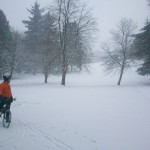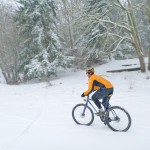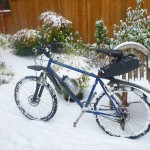Travel Gifford
On my last blog post I mentioned a secret project. I built an adventure touring bike (basically the same geometry as Gifford) that uses S&S couplers to make travel easier while waiting for the dropouts to arrive for my other frame project. I’m really happy with how this one came out, especially since I started it only 4 weeks ago. This also makes it the first complete bicycle to come off of my new frame fixture.
As I mentioned it is very similar to Gifford. The head tube angle is 73 degrees and the seat tube angle is 72.5 degrees. It is built for 26″ (559mm) wheels because they pack a bit more easily into S&S cases and it will be easier to find replacement tires in foreign countries. There is tons of tire clearance, the photos here show it with 50mm knobby tires and fenders will fit above those. I’ll probably run it with 45mm or so slicks most of the time. The 60mm knobby tires from my mountain bike even fit.
The frame is a bit larger than the other Gifford to make it on the slightly large size for me and to make it fit many of my taller friends who might use this as a loaner bike. Sizing is about the same as a 60cm Long Haul Trucker. This one is also built with derailleurs instead of a Rohloff hub to keep costs down. Tubing is similar to the first Gifford, Columbus SL (standard diameter 9/6/9) front triangle, the same Nova single bend chainstays, and some True Temper oversized seatstays that looked good to my eye.
It will eventually get a coupled porteur rack to go along with it. It is shown here only partially assembled because my friend Andre is going to do the rest of the assembly and give it a test ride. He is interested in this style of bike and is waiting for the next batch of Rawlands rSogn frames to be made. In the meantime he’ll get to use this one for a few months.


Lots of tire clearance up front under the Pacenti Biplane crown

Lots of tire clearance in back too. The oversized double taper seatstays will make the braking firm.

The seatstay cluster is fairly plain, but gets the job done. This is the trickiest part of the bike for me to get right.

Single bend chainstays clear 48/38/24 chainrings (barely) and provide good tire clearance.
There are more photos on my smugmug site.
I’m going to be asked how I got the S&S couplers. These were removed from a damaged frame but where the couplers were intact. I cleaned them up carefully and reused them. It would be nice if S&S sold them to hobbyists, but I understand why they don’t. I really enjoyed working with the couplers, they must be the most precise lugs ever made. The fit was perfect and they have very nicely tapered edges. I inserted the couplers into my downtube and toptube before they were brazed into the frame, but after the tubes were mitered and fit to my jig. That method seemed to work nicely for me, and the couplers have perfect alignment.
I’m really excited to get this one on the road. I have a bit of travel coming up soon and may bring the bike with me, even though I hadn’t really planned on bringing a bike. In the meantime I look forward to hearing what Andre has to say about the ride.





























































